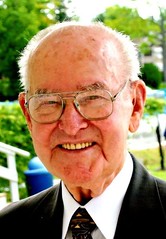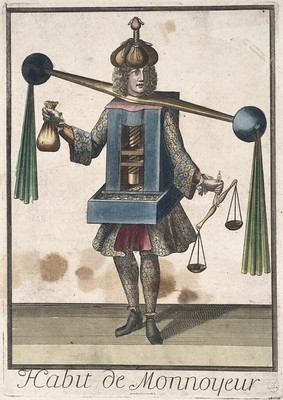
PREV ARTICLE
NEXT ARTICLE
FULL ISSUE
PREV FULL ISSUE
NOTES FROM E-SYLUM READERS: MARCH 22, 2020Howard Daniel Remembers Ray Dillard
To read the earlier E-Sylum article, see:
Daniel "Tiny" Cross (1960-2020)
"It was announced today that Daniel "Tiny" Cross passed away. He was one of the great fixtures of the ANA's Summer Seminar and a really sweet guy who will be missed by all who knew him. I had some great times with him, and he'll always be remembered as the seminar's unofficial "taxi" driver with his college golf cart." Sorry to hear the news. -Editor Here's a link to his funeral home page:
Tatham Stamp & Coin Co. Envelope
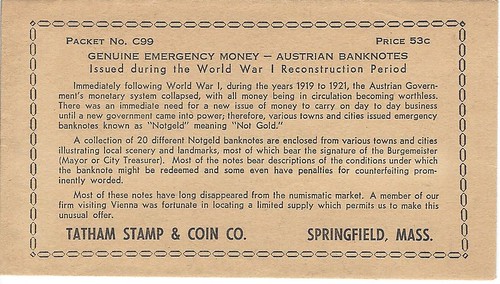 Jeremy Schneider writes: "With essentially everything locked down here in Denver, I have had some time to go through my collection- especially a lot that I purchased last year at a garage sale. Late last summer, I purchased a large album and shoe box of miscellaneous international currency and random numismatic "stuff". Although at the time I briefly flipped through it and pulled things that I knew were interesting (a $10 national bank note, win!) I essentially set it aside for a rainy day. "One thing I found interesting in the collection that I wanted to send your way was this small envelope from the deal Tatham Stamp & Coin Co. Springfield Mass. I know that there has been a running article on historic coin dealers (perhaps there is a book being written as well?) but thought that this may be helpful in research etc. " Thanks. Anyone else have one of these in their ephemera collection? -Editor 'Spending' Liberty Dollars
"The item on the ephemeral Liberty Dollars reminded me of a time when I was working for Harlan Berk and silver was priced at just below $7 an ounce and the one ounce silver Liberty Dollars were "denominated" at $10 each. A man came in and tried to make a $9.95 purchase with one, and as he tendered it (loose from his pocket and slightly mishandled) said "You HAVE to take this for ten dollars!" Bemused, I spent several minutes arguing with him about why my offer to take it in trade at the spot price of silver was more than reasonable. I do believe that the man was quite serious in his mistaken belief that the fantasy denomination was real, which just goes to show you the power of propaganda and the gullibility of fools." To read the earlier E-Sylum article, see:
Anne Bentley of the Massachusetts Historical Society forwarded this delightful if creepy image of a moneyer as one with his coin press. From a newly released collection of images. -Editor Paris Musées, a collection of 14 museums in Paris have recently made high-res digital copies of 100,000 artworks freely available to the public on their collections website. Artists with works in the archive include Rembrandt, Monet, Picasso, Cézanne, and thousands of others. So.. who's this artist? Could anyone track that down for us? Interesting. -Editor Anne adds: "It could definitely serve as a Halloween costume in the times of social distancing!" To read the earlier E-Sylum article, see:
Cambodian, Burmese or Indian Hamsa Bird Medal?
 Howard Daniel writes: "I have been seeing this medal for about a year now and have been twice asked to identify it. The current owner, Atlas Numismatics, has it listed for US$2950.00 with Inventory Number 1053147 and described as issued during the time of King Sisowath I of Cambodia. He was the king from 1904 to 1927. The gold medal is dated 1905 with UVA and certified by NGC. "Cambodia is as good a guess as any but I believe the medal is possibly from the time of British Burma and not Cambodia. If it was French Cambodian the UVA (United Veterans Association?) would likely be AVU in French. The bird is also a very strong (more like a goose) Hamsa bird, which was commonly used back in 1905 and previous years in Burma (and India). The diameter of 22mm and the weight of 7.36 grams does not fit into other Cambodian medals, or Burma for that matter. It is even possible the medal could have been awarded by and organization within the University of Virginia! "If a reader has any idea where this medal was issued and by whom, please contact me, Howard A. Daniel III, at HADANIEL3@MSN.COM and Atlas Numismatics at INFO@ATLASNUMISMATICS.COM. Thank you very much in advance." Interesting attribution problem. Can anyone help? -Editor Vincent Contamin, Contamin Pantograph Inventor?
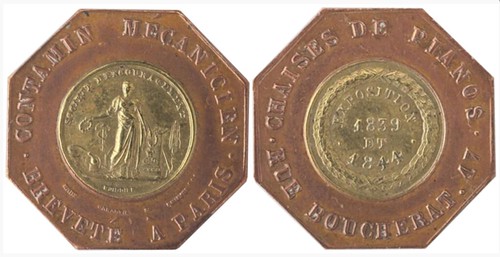 David Powell writes: "You quote in the latest E-Sylum: "The inventor, Contamin (the remainder of his name has been lost to time) was French." "Not definitely proved, but my suspicion is that the inventor concerned was Vincent Contamin {1800-1881}, father of Victor Contamin {1840-1893}, a prominent engineer for whom there is a Wikipedia entry. "Vincent himself does not seem to be mentioned by forename in any articles about the activities of the older M.Contamin in the 1830s and 1840s, but he does occur as Victor's father on one or two family history websites. However, they do not say much about him. "The excellent French paranumismatic/exonumia website https://wikicollection.fr/ has a token issued by someone who, is in all probability, the pantograph inventor whom Robert Whithead speaks of. He is described on the token as a mécanicien {engineer}, although his stated activities relate to pianos and the chairs associated with them. There are several Google Books references to this side of his work "All rather speculative, but it may be of use to someone who wants to follow it up." Excellent lead! What do readers think? -Editor Links:
To read the earlier E-Sylum article, see:
Fugio Cent Die Trial Discovery
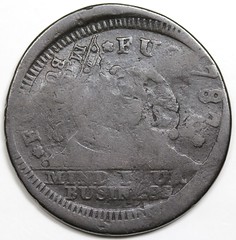 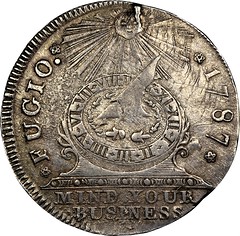
Fugio Cent die trial and a later spalled and cracked state Craig Sholley writes: "John Dannreuther and I recently made a fantastic discovery. We thought the double-struck Fugio cent die trial was the only known strike from the Yale Museum 107 obverse die based on the lower cinquefoils positions. However, in looking more closely, JD noted that the rotation of the cinquefoil below F did not match that on the 107 die. On the double-struck piece, the one lobe of the cinquefoil points at the junction of the upright and the serif of F, while on 107, one lobe points above the top serif of F and the other points t the junction of the upright and the left lower serif! Obviously, the double struck piece IS NOT 107. "After a little more comparison, we realized that this rotation matches a single die - the Newman 105 obverse! Thus, this die trial was most likely struck in 1861 by John K. Curtis shortly after he had purchased the dies (105 and QQ) from Horatio Rust and shortly before the he had the silver pieces struck. Since the 105 die was lightly cracked from the rim to the top of the sun in the earliest state of 105-QQ, the die trial is likely a "test strike" to see if the die would hold up under striking. "I've attached images of the die trial and a later spalled and cracked state of 105. The earliest state of 105 is picture in Newman." Great discovery! -Editor  Wayne Homren, Editor The Numismatic Bibliomania Society is a non-profit organization promoting numismatic literature. See our web site at coinbooks.org. To submit items for publication in The E-Sylum, write to the Editor at this address: whomren@gmail.com To subscribe go to: https://my.binhost.com/lists/listinfo/esylum All Rights Reserved. NBS Home Page Contact the NBS webmaster 
|
